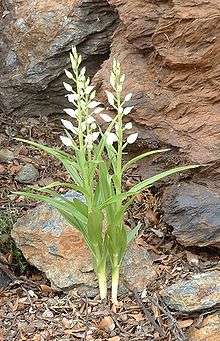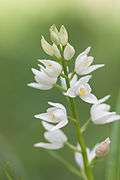Cephalanthera longifolia
Cephalanthera longifolia, known by the common names narrow-leaved helleborine[2] or sword-leaved helleborine or long-leaved helleborine, is a herbaceous perennial plant with rhizomes of the family Orchidaceae. It is native to light woodland, widespread across Europe, Asia and North Africa from Ireland and Morocco to China. This includes Iran, Russia, Kazakhstan, Turkey, Algeria, India, Pakistan, Germany, Italy, France, Spain, Portugal and many other countries.[1][3][4]
| Sword-leaved Helleborine | |
|---|---|
 | |
| Sword-leaved Helleborine (Cephalanthera longifolia) | |
| Scientific classification | |
| Kingdom: | |
| (unranked): | |
| (unranked): | |
| Order: | |
| Family: | |
| Subfamily: | |
| Tribe: | |
| Subtribe: | |
| Genus: | |
| Species: | C. longifolia |
| Binomial name | |
| Cephalanthera longifolia (L.) Fritsch 1888 | |
| Synonyms[1] | |
| |
Description
Cephalanthera longifolia reaches on average 20–60 centimetres (7.9–23.6 in) of height in typical conditions. This orchid has erect and glabrous multiple stems. The leaves are dark green, long and narrowly tapering (hence the common name of Sword-leaved Helleborine). The inflorescence is a lax, five to twenty-flowered spike with the bell-shaped flowers ascending in an oblique spiral. The flowers are white, about 1 cm (0.4 in) long, with a yellow-edged labellum and they usually open only during the warmest and brightest hours of the day. This plant can be found in bloom from April to June, depending on location and altitude. The fruit is a dry capsule and the dust-like seed is dispersed by the wind.[5]
One unusual characteristic of this species is that some individuals are achlorophyllous (lacking green pigment) and take all their nutrition from mycorrhizal fungi.[6]
Ecology
The flowers are pollinated by solitary burrowing bees. The flowers produce little nectar and the yellowish dust on the labellum which the insects collect is of little nutritional value. The actual pollen is contained in two pollinia which adhere to the hairs on the bee's back.[5]
An investigation in Estonia determined that the mycorrhizal partners of this orchid species include Thelephoraceae and Helotiales.[6] Another investigation indicated 9 mycorrhizal partners (still fewer than those recorded for Cephalanthera damasonium): Bjerkandera adusta, Phlebia acerina, Sebacinaceae, Tetracladium sp., and Tomentella sp.[7]
Cephelanthera longifolia is vulnerable to grazing by deer.[8][5]
Distribution
Cephalanthera longifolia is common in some parts of its European range, such as southern France and Spain, but endangered particularly in northern areas such as Belgium. In Britain and Ireland it is a quite uncommon and declining species, and conservation work is being carried out at a number of sites to safeguard it (see also Galley Down Wood). In 2007 it was listed as a priority species under the UK Biodiversity Action Plan. The charity Plantlife International is leading this work in the United Kingdom.
Habitat
Sword-leaved Helleborine usually grows in damp woodland places (mainly oak and beech), forest edges and rocky slopes.[5] These plants prefer calcareous soils and in well exposed places, at an altitude of 0–1,400 metres (0–4,593 ft) above sea level.
This species was once abundant, when forests were used for grazing livestock and trees were coppiced, but is now threatened by overgrowth of larger plants. As the flower spikes are eaten by deer, the sword-leaved helleborine is also threatened by the increase of deer populations following extirpation of large predators like wolf and brown bear in many parts of Europe.[5]
Etymology
The genus name Cephalanthera comes from the Greek κεφαλή kephalē (head) and ἄνθηρα anthēra (anther): the anther is placed at the top (head) of the column.[9] The Latin name longifolia means with long leaves .
"Helleborine" may refer to deer using the orchid for food (many conservationists have noted that helleborine orchids are grazed by deer [10][11][12]). Alternatively it may denote that the plants are similar to hellebores (a group of species in the family Ranunculaceae). "Hellebore" comes from the Greek "álkē" and "bora", translating as "fawn" and "food of beasts".[13]
In German, Cephalanthera are referred to as Waldvöglein, meaning little birds of the wood, a reference to the winged appearance of the flowers.
Gallery
Whole plant |
Close-up on a flower |
Flower |
Inflorescence |
Leaves |
 Inflorescence |
References
- Kew World Checklist of Selected Plant Families
- "BSBI List 2007". Botanical Society of Britain and Ireland. Archived from the original (xls) on 2015-01-25. Retrieved 2014-10-17.
- Flora of China, v 25 p 177, 头蕊兰 tou rui lan, Cephalanthera longifolia
- Altervista Flora Italiana, Cefalantera maggiore, Narrow Leaved Helleborine, Cephalanthera longifolia
- "Narrow-leaved Helleborine: Cephalanthera longifolia". NatureGate. Retrieved 2013-12-30.
- Canadian Journal of Botany - Cephalanthera longifolia is mixotrophic
- Journal of Systematics and Evolution
- Woodland Wildlife Toolkit - Narrow-leaved helleborine
- Gilbert-Carter, H. (1955). Glossary of the British Flora. Cambridge University Press. p. 19. OCLC 867791719.
- Plantlife - Epipactis youngiana
- Wildflower Society Online Report
- Finnish Orchids
- Dictionary.com
- Pignatti S. - Flora d'Italia (3 voll.) - Edagricole - 1982
- Tutin, T.G. et al. - Flora Europaea, second edition - 1993
- Acta Plantarum
External links


- "Cephalanthera longifolia" at the Encyclopedia of Life

- Den virtuella floran - Distribution
- Plantlife website - species listing
- Naturdata page on Cephalantera longifolia with pictures and information for this species in Portugal
- Biolib
- Cephalanthera longifolia